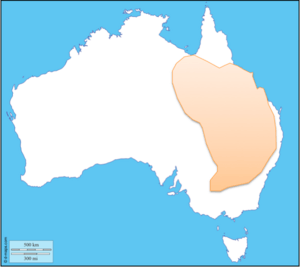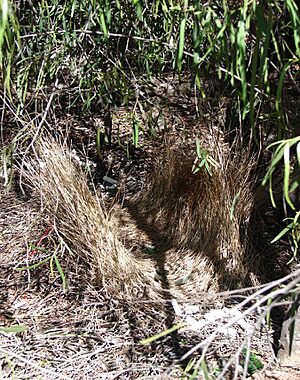Spotted bowerbird facts for kids
Quick facts for kids Spotted bowerbird |
|
|---|---|
 |
|
| Conservation status | |
| Scientific classification | |
| Genus: |
Chlamydera
|
| Species: |
maculata
|
 |
|
| Distribution of the spotted bowerbird | |
| Synonyms | |
|
large-frilled bowerbird, cabbage-bird or mimic-bird. |
|
The spotted bowerbird (Chlamydera maculata) is a medium-sized bird that lives in the drier parts of eastern Australia. Like other bowerbirds, it's famous for its amazing behaviors. These include building and decorating special structures called "bowers," performing dances to attract mates, and copying many different sounds. Even though you can find spotted bowerbirds in many places, their numbers are slowly going down.
Contents
What They Look Like
Spotted bowerbirds are about 29 centimeters (11.4 inches) long. They are slim and compact. Both male and female spotted bowerbirds look alike. Their heads are a light reddish-brown with gray-brown streaks. They have a special lilac-pink crest (a tuft of feathers) on the back of their neck.
Their upper parts are dark brownish-black with many amber (yellow-orange) spots. Their undersides are lighter, creamy with grayish patterns, and a bit yellow on their lower belly. They have a black beak, dark brown eyes, and olive-brown legs.
Their Amazing Calls
Spotted bowerbirds make many different sounds. They have loud, harsh calls. But what's really cool is that they are excellent at copying other sounds! They can mimic the calls of many different birds. They can even copy other noises they hear.
For example, if a human or another animal comes too close, male bowerbirds at their bowers and females at their nests often copy the calls of dangerous birds. These include the wedge-tailed eagle (a large bird of prey), the blue-winged kookaburra, and the australian magpie. They also mimic sounds like large animals walking through bushes, the sound of a fence wire twanging, wood being chopped, a stock whip cracking, and even the sound of crested pigeons flying.
About Their Name
The spotted bowerbird was first described by a scientist named John Gould in 1837. Its scientific name has changed a few times, but now it's usually called Chlamydera maculata. This bird is a unique species, meaning there are no different types or subspecies of it.
Where They Live
Spotted bowerbirds mostly live in dry, open woodlands. These areas have lots of Eucalyptus trees and other small trees and bushes. Their spotted feathers help them blend in with their surroundings, making them hard to see. They especially like areas near rivers. You can also find them in orchards, parks, and even in gardens around homes in the countryside.
What They Eat
Spotted bowerbirds mostly eat fruit, flowers, and seeds. They also eat insects. They are known to take food scraps from campsites and houses. They might even visit orchards and gardens to find fruit.
These birds usually look for food alone or in small groups. However, when they are not busy with their nests or bowers, you might see them in larger groups of 10 to 30 birds.
How They Behave
Reproduction
Spotted bowerbirds breed for a long time, from July to March. Most of their eggs are laid between October and February.
Building Bowels
Male spotted bowerbirds are special because they build and take care of structures called "bowers." These bowers are like special display areas. They help the male show off how good he is to female birds.
Spotted bowerbirds build "avenue-bowers." These are made of grass and twigs and are wider than the bowers of many other bowerbirds. Males might even paint the walls of their bowers using chewed-up grass and their own saliva! Bowels are usually built under large, thorny bushes that offer protection and fruit. Some bower sites are used for more than 20 years, with different males rebuilding them each year.
Decorating Display Courts
Right next to their bowers, males create "display courts." They decorate these courts with all sorts of things! They use leaves, flowers, fruits, seed pods, insect parts, shells, eggshells, bones, stones, and charcoal. They also use human-made items like glass, wire, foil, and other metal objects.
The more decorations a male has, and the type of decorations, can show how successful he is at finding a mate. This suggests that decorations help females choose the best male. The kinds of decorations preferred by spotted bowerbirds can be different depending on where they live.
Courtship Display
Once a female comes to a bower, the male performs a fancy dance to impress her. He makes sounds throughout his display. What's unique about spotted bowerbirds is that the female watches this energetic dance through the partly see-through northern wall of the bower.
- During the main part of the display, the male stands tall near the bower. He raises his wings and shows off his lilac-pink crest, which is bigger in males who own a bower. His movements are quick, jerky, and look like he's putting in a lot of effort.
- In the second part of the display, males walk in wide circles around their bower. They hold their head up, open their beak, cock their tail, and droop their wings. Males often use their decorations as props. They might hold them in their beak or pick them up and throw them down. These courtship displays can last for minutes or even more than an hour!
Nesting
Unlike the males, female spotted bowerbirds do all the work of raising their young. Females build nests in trees and bushes, sometimes in mistletoe plants, usually about 6 meters (20 feet) above the ground. The nest is made of fine twigs on a base of larger sticks.
They usually lay just one egg. The egg is oval-shaped and a pale greenish-gray with strong, wavy patterns of dark brown and black. Scientists don't yet know how long it takes for the eggs to hatch or for the chicks to leave the nest.
How They Are Protected
The spotted bowerbird is listed as "least concern" by the IUCN Red List. This means they are not in immediate danger of disappearing. However, their numbers are going down overall. They have disappeared from some areas where they used to live, especially in the southwest. They are now completely gone from South Australia.
Why are their numbers declining? People sometimes illegally shoot or poison them because they see them as pests. Also, animals like feral cats and red foxes (which were brought to Australia) hunt them. Finally, their homes are being destroyed or changed by humans, which breaks up their living areas.
Images for kids
See also
 In Spanish: Pergolero moteado oriental para niños
In Spanish: Pergolero moteado oriental para niños





